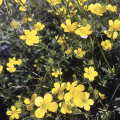Muddy Water
Muddy Water
Muddy water limits fish production in ponds because the phytoplankton (single-cell plants) at the base of the food chain must have sunlight to grow. Silt and mud deposits also cover fish eggs and fill the pond, and most pond fish feed using their sight.
Controlling the erosion in a pond’s watershed is essential for permanent control of most muddy-water problems. If livestock are muddying your pond, fence off the pond and install drinking troughs below the pond. Some fish species, such as bullheads and common carp, can keep a pond muddy. In this case, renovate the pond and start over.
After you have identified and corrected the source of muddy water, test your pond water for alkalinity. Ponds with low alkalinity also tend to have low hardness and variable pH, which can cause clay particles to remain in suspension for long periods of time. If alkalinity is less than 50 ppm, adding agricultural limestone may help clear the pond. Spread 2 tons of crushed agricultural limestone per surface acre following the recommendations presented in the Water Quality section. The limestone dissolves and releases calcium and magnesium ions that settle the clay over several weeks. Once the pond is cleared, the small algae begin to grow, and muddy water conditions are unlikely to redevelop.
If alkalinity is above 50 ppm or if adding agricultural limestone does not clear the pond, one of the following methods may help remove the clay from the water:
- 500 pounds of organic material per surface acre, such as old hay (approximately 10 square bales per acre broken up and broadcast evenly over the pond surface), cotton seed husks, compost, or other similar organic material. Be careful using organic material in the summer, since decomposition may deplete oxygen and cause fish to die.
- Apply 40 to 90 pounds of alum (aluminum sulfate) per acre-foot of water. The dosage depends on the severity of the muddy water. Treat moderately turbid water (can see about 12 inches in the water) at 40 pounds per acre-foot, but severely turbid water (can see less than 6 inches into the water) may require up to 90 pounds per acre-foot. This translates to about 200 to 450 pounds of alum per surface acre of water for a pond with 5-foot average depth. Alum removes alkalinity from ponds, lowers pH, and can lead to fish kills in ponds with low alkalinity. To counteract this, apply hydrated lime at the same time as alum at half of the alum rate. Hydrated lime by itself can cause fish kills, so be careful when using this method to clear ponds.
- Use gypsum (calcium sulfate dihydroxide) at the rate of 1,300 to 3,000 pounds per surface acre of water, depending on the severity of the turbidity. Spread the gypsum from a boat over the pond surface, and stir with an outboard motor. The gypsum keeps the water clear as long as the gypsum is not washed from the pond. When used according to recommendations, it does not kill fish, change the pH of the water, or harm livestock. When water clears, you can return to your regular fertilization program.
Publications
News
Whether you have a large lawn, field, or pasture, you’ve probably had to deal with pesky weeds.
BILOXI, Miss. -- The Southeast has some of the most commercially and recreationally valuable fisheries in the United States.
Success Stories
Billy Mitchell spent his childhood summers in the water and has lived at Pelahatchie Bay for more than three decades, so his dedication to protecting water resources now almost makes too much sense.







